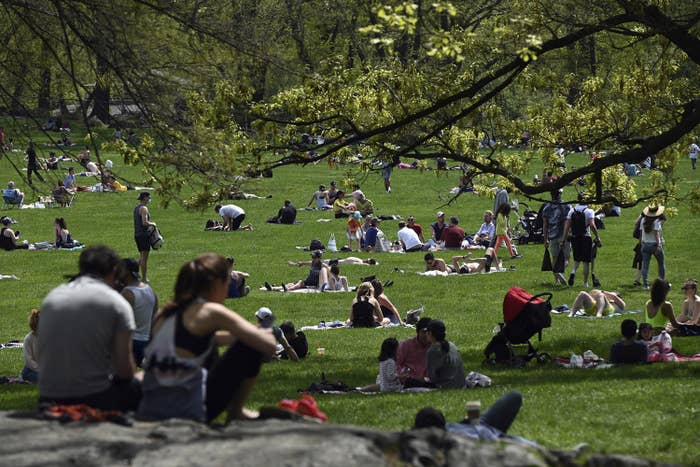
BuzzFeed News has reporters across five continents bringing you trustworthy stories about the impact of the coronavirus. To help keep this news free, become a member and sign up for our newsletter, Outbreak Today.
On a weekend in which more than 500 New Yorkers died of the coronavirus, according to the state’s governor, thousands more people headed to public parks to enjoy the city’s first warm weather in some time.
With most New Yorkers having been in lockdown for more than two months, families and friends could be seen enjoying the outdoors and picnicking as people sunbathed on the grass.
But several photos went viral over the weekend that showed throngs of people not wearing masks who had crowded into the Christopher Street Pier parks in Manhattan in apparent defiance of social distancing.
it has been nothing short of an honor to have stayed inside for 8 weeks for these amazing people in the west village today <3
Christopher Street Pier - 4:48pm. Not sure if the message is getting through.
It’s important, of course, to remember that some photos of crowds can be deceptive. Indeed, pictures taken by Gothamist appeared to show at least some distance between some of the people at Christopher Street Pier.
But the viral photos — as well as images of large groups of people enjoying some beaches in Florida and California in recent weeks — fueled anger among people who are doing their best to stay home as much as possible.
Some experts told BuzzFeed News they were also alarmed by the apparent crowding on display by people not wearing masks.
“The images of New Yorkers close to each other in parks, without face masks, is disturbing,” said Vincent Racaniello, professor of microbiology and immunology at Columbia University. “They should either be maintaining social distance, or ideally, wearing face masks.”
“I’m very concerned about them,” said Aaron Glatt, a doctor at Mount Sinai South Nassau hospital and a spokesperson for the Infectious Diseases Society of America (IDSA). “If people aren’t going to keep appropriate social distancing and appropriate wearing of masks, we will unfortunately see a resurgence of this illness.”
BuzzFeed News asked seven doctors, scientists, and public health experts about whether they would visit an open park or a beach with their families — and what precautions they would take if doing so.
We also reached out to the governors of California, Florida, and New York for comment. The offices of Gov. Gavin Newsom of California and Gov. Andrew Cuomo of New York responded, referring to comments they had made at press briefings. (Some comments have been edited and condensed for clarity.)
CAN I VISIT A PARK OR BEACH AS LONG AS I AM STAYING SIX FEET AWAY FROM OTHER PEOPLE?
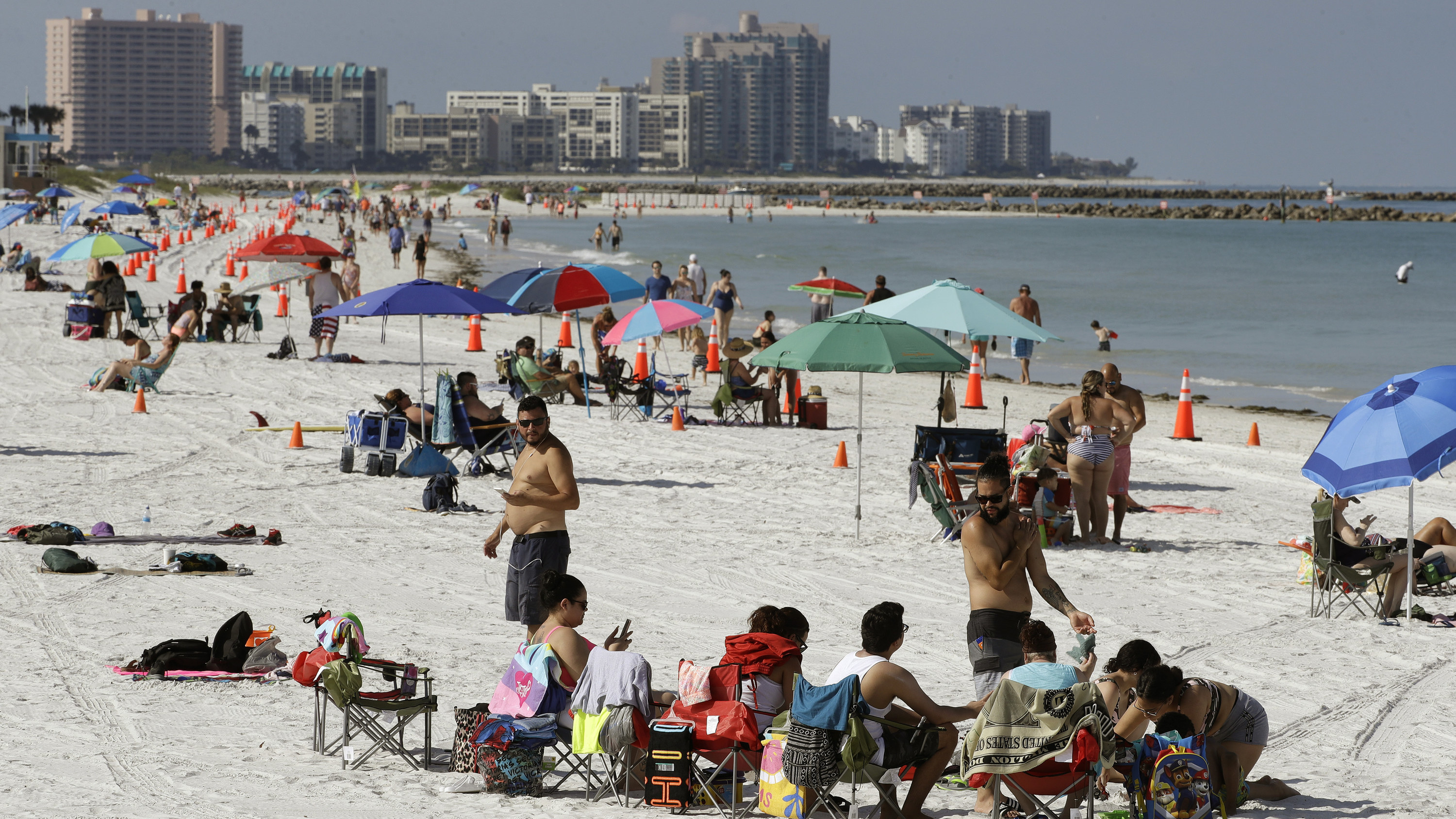
Rosie Redfield, microbiologist at the University of British Columbia’s Department of Zoology: I’ve been thinking about this a lot. … At 6 feet apart, in the open air, the only real concern is that you might inhale dried-up respiratory particles (droplet nuclei) carrying infectious virus. These float in the air (they don’t fall) and are produced when an infected person coughs or sneezes, but also when they shout or even talk loudly. Separation by 6 feet gives large droplets that haven’t yet dried up time and space to fall to the ground, and provides a lot of air volume for the dried particles to disperse in.
Amesh Adalja, infectious diseases physician and senior scholar at the Johns Hopkins Center for Health Security: For those that are in high-risk groups or are in contact with high-risk groups, then the decision-making may be different for somebody that’s not. I don’t think there’s going to be a one-size-fits-all decision that people make.
Susan Kline, a professor of medicine with the University of Minnesota’s Division of Infectious Diseases and International Medicine and another IDSA spokesperson: Well, I think that if the people are very close to each other then there’s potential for the spread of coronavirus. I think if people go out in public, there likely are safe ways to do it and unsafe ways to do it.
I think we have to keep in mind that somewhat arbitrary distance of 6 feet. But I think 6 feet or farther is definitely safer than closer than 6 feet to people. So I think distancing is one measure that can help.
I think the other measure that can help is limiting the time that you’re closer than 6 feet with other people.
Gerardo Chowell, professor of epidemiology with Georgia State University’s School of Public Health: I think it’s completely OK to go to the park, but you need to plan for it and be careful.
We need our time to go to the park and have a walk, otherwise we’re going to start seeing mental health issues. But we can do it in ways that are not hard. It’s just about being conscious of this virus that generates asymptomatic conditions and being aware of that and keeping our guard up.
In this high-temperature weather, it’s a very low-risk environment. Obviously, if you want to reduce the risk even further, bring a face mask.
Gov. Newsom (speaking at a Monday press briefing): There’s been some reporting ... that parks somehow are closed. We have over 200 state parks that have been open that remain open. … There are some that have partial closures — parking lots and the like — but still [there are] activities in all of these parks, large and small, across the state and across our beaches. But again with the modifications in place. … More information on these modifications will come to light ... on Thursday. (Newsom also referenced two Orange County beaches that had reopened to allow active recreation — e.g., swimming and running — but would not allow sunbathing or gatherings with coolers.)
WOULD YOU TAKE YOUR FAMILY TO A BEACH OR PARK?
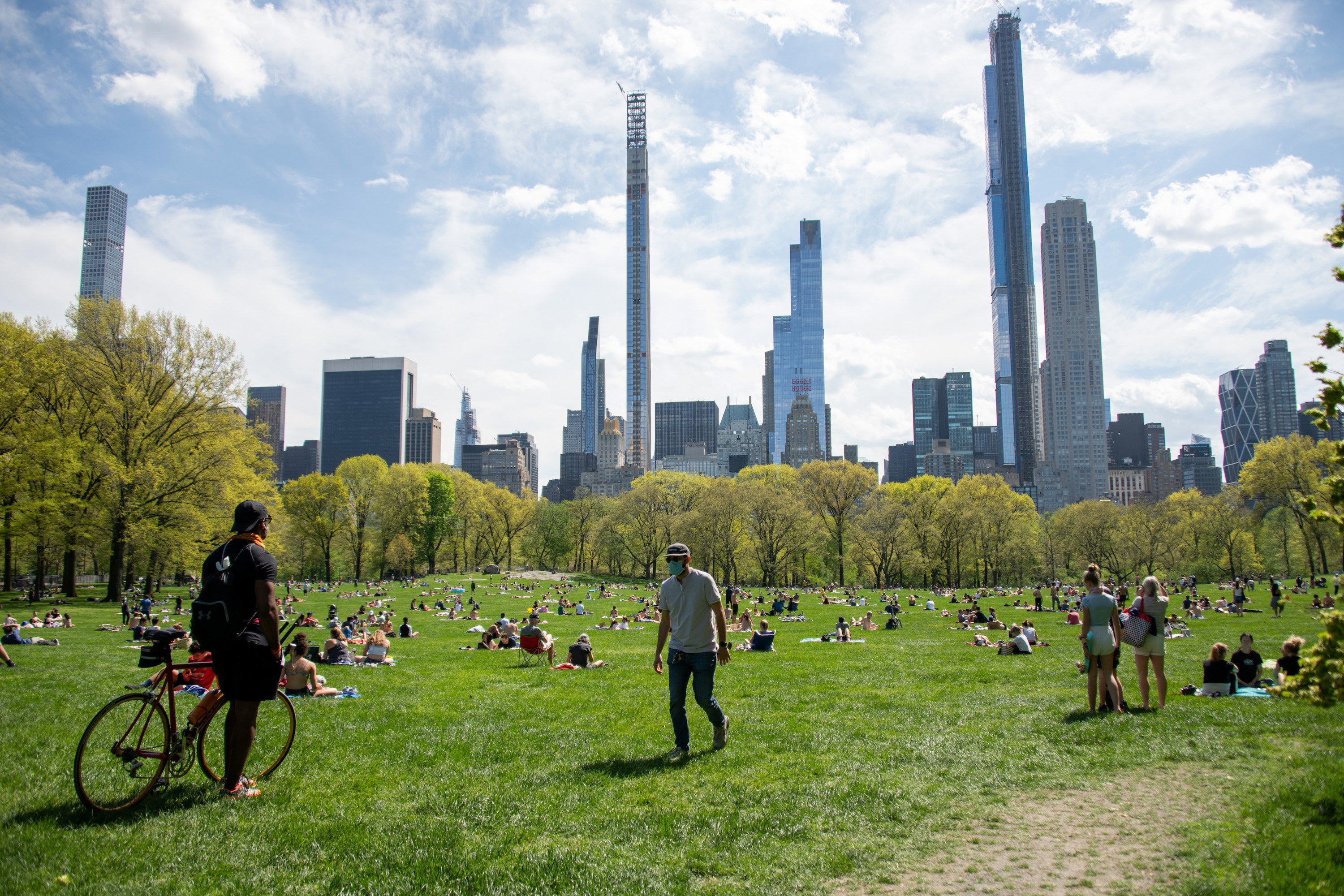
Robin Patel, president of the American Society of Microbiology: I might take those living in my household to an uncrowded park, but would leave if we were not able to comfortably stay at least 6 feet away from others at all times. I would also factor in how we would get to the park without risking an exposure.
Glatt: I would only go with my family to a place where I could appropriately keep social distancing. A walk in the park, a walk on the street, is a beautiful way to spend time with your family, get fresh air, get exercise, but — the critical “but” there — it has to be done in a way that’s socially responsible.
I will not do it if I’m going to be in close proximity to a lot of people and I certainly won’t do it if I’m going to be in close proximity to people who aren’t wearing a mask.
I even try to stay further away than that, but certainly a minimum of 6 feet. [I try to stay] as much as is appropriate.
When I’m taking a walk with my wife and I see people I know across the street, we stay across the street and wave. We don’t try to get close.
Adalja: As long as none of them had any kind of health problems that made them vulnerable or were going to be around people that had health problems, then yes. As long as people are being careful and using common sense.
Redfield: Yes.
Chowell: I would take them, yes — with precautions. If I expect to see other people there, I would make sure that we bring a face mask. It would not be a lot of fun. I would go to the park for a walk but I wouldn’t stay there for too long — a walk for 30 minutes and then return. That’s probably the type of trip I would make to the park.
Gov. Cuomo (speaking at an April 16 press briefing): I've been on Coney Island on that beach many times – hundreds of thousands of people packed tightly together. Like, I don't see that happening anytime soon. So then, obviously, you could have a situation where people can go to the beach to walk along the beach, but not in large numbers anytime soon. We still have to observe social distancing. I know people are doing that now. But the notion of having lifeguards and people coming to the beach like normal, we don't have that in our sights yet. I think it's going to be tough to project. Right now, I'd say, lower expectations — just for everyone's sanity, lower expectations.
(Cuomo’s staff also pointed to physical distancing guidelines that encourage people to “stay home as much as possible, keep at least 6 feet between yourself and others, do not gather in groups, work from home, and avoid all nonessential travel and interactions.”)
HOW CROWDED WOULD IT NEED TO BE BEFORE YOU FELT UNCOMFORTABLE?

Adalja: I’m an infectious disease clinical care physician, so I’m taking care of these patients and getting exposed at a higher degree than most other people. So I have a very high risk tolerance. I think I probably have antibodies to it because I’ve been around enough patients. So I think that’s going to differ for each person, and each person’s risk tolerance is different.
Redfield: Thinking rationally (not “feelings”), the risk of infection in a park would be higher if a) the park was packed with people, all exactly 6 feet apart; b) the air was still (no wind to disperse the particles); and c) the incidence of active COVID-19 infections in my community was high. If all of these were true, I’d stay home.
Kline: This weekend I did go out myself and went on the bike-riding path in Minneapolis–Saint Paul, and there were quite a few people out walking or riding their bikes. I did see some people on beaches down by the Mississippi River, but I think when you’re on a bike path you have to pass people closely.
Two things you can do is keep that passing time to the shortest time possible and the other would be to have a mask on when you have to pass.
I did notice that at some of the parks I went to there were little groups of people together, probably family groups or close friends, but for the most part they were a couple people or small groups, so I think that type of gathering is OK as long you’re 6–10 feet away from other small groups.
Chowell: You can put a piece of fabric or rope on the floor and mark your space. … Marking your space is more important than ever and respecting other spaces is equally important. Wearing a face mask is also a sign of respect for others.
WOULD YOU WEAR MASKS?
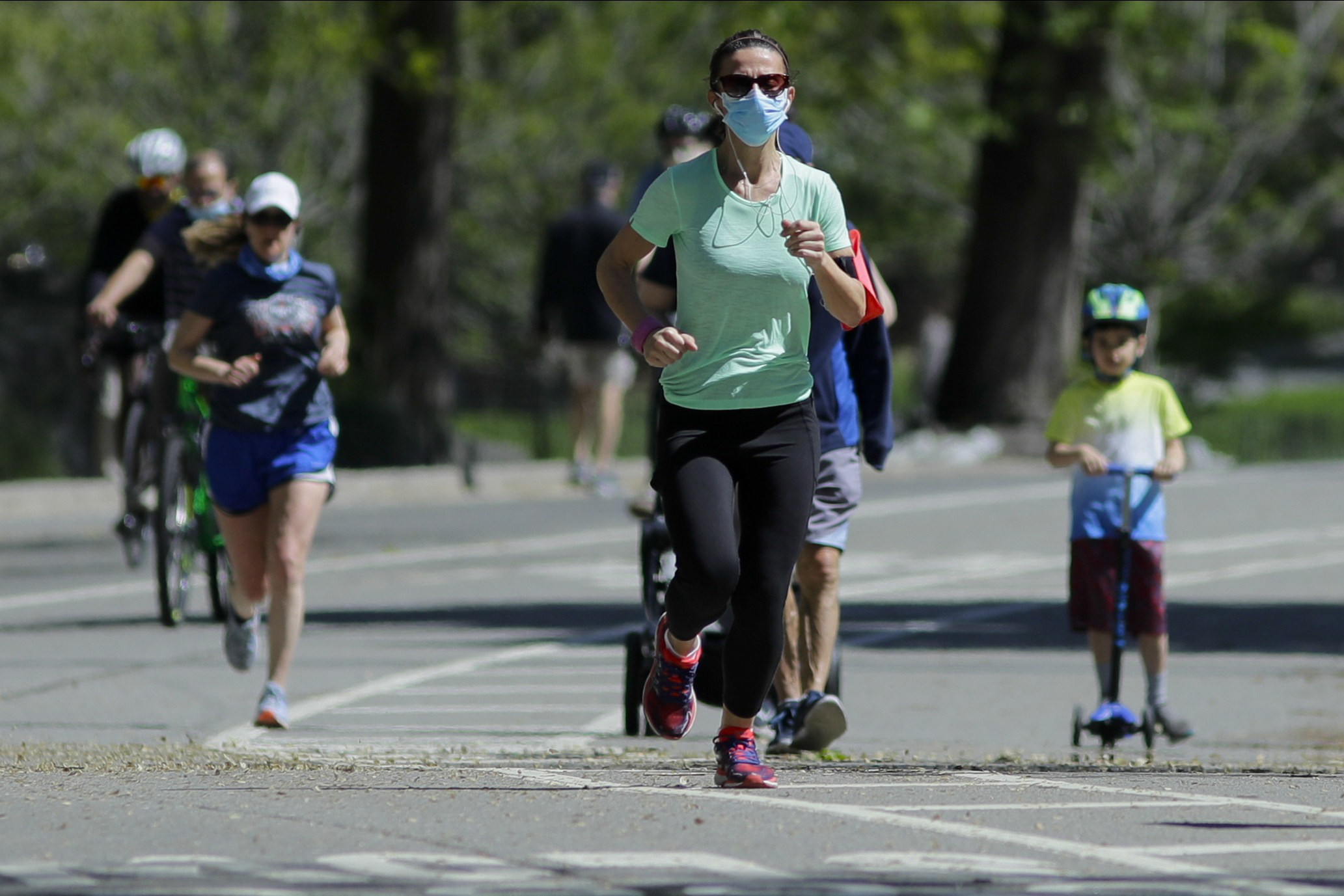
Racaniello: I would certainly go to a park or beach if I were not holed up in front of my computer seven days a week!
I would make sure that we all wear face masks. With face masks, you can get closer to people (which can happen accidentally) without risking infection. Otherwise, keep 6 feet away!
Chowell: If I fall into a higher risk group, then I should be wearing a mask. I may run into someone. What am I going to do? Start running?
Obviously if there’s a lot of people in the park, you must bring a face mask because you cannot control your space all the time. People may run into your 6-feet radius sphere. If it’s crowded and you still want to go to the park, yes, bring your mask. There’s no other way.
If it’s not crowded and you’re going to be walking on the outskirts, it’s probably fine [not to wear a mask]. But if you want to go to the park and meet with people not in your household, then I must wear a face mask, particularly if you’re going to spend a substantial amount of time talking.
Adalja: A lot of these places have their own regulations and I think that depends on what the regulation is. Obviously, if it’s private property and you’re at a private park or beach and that’s the requirement to enter, then I think you have to wear it.
But ideally, if you’re not within 6 feet of someone else, you shouldn’t necessarily have to wear a mask. I would also say there’s not great data that shows that wearing masks actually decreases transmission, especially the homemade masks that people are wearing. I’m less of a supporter of the mask policy. However, I think that it is something that has been universally accepted by many people.
Gov. Cuomo (speaking at a press briefing on Monday): You don’t wear a mask for yourself. You wear a mask to protect me. I wear a mask to protect you. We owe each other a certain amount of reasonableness and respect in society, and I owe you that level of respect.
Wear a mask if you may be in a situation where you can’t socially distance. If you go for a walk in the woods, you don’t have to be wearing a mask. If you come to a point where you’re going to be in a parking lot or there’s an entrance and an exit, wear the mask.
Redfield: I hate masks (maybe irrationally); most don’t provide much protection from infection, and if they do (well designed, tightly fitting) they’re hot and stuffy. If the risk of infection was high enough to warrant wearing masks I’d probably stay home. I’m also not convinced that they provide much protection from spreading the virus if you yourself are infected (a sneeze or cough will blow right by them).
Kline: If you’re out in a crowd in a space where you can’t keep a distance, wear a mask, and ideally everyone should wear one to minimize the spread.
WOULD YOU GO OR NOT GO TO A PARK OR BEACH ON CERTAIN DAYS OR CERTAIN TIMES?
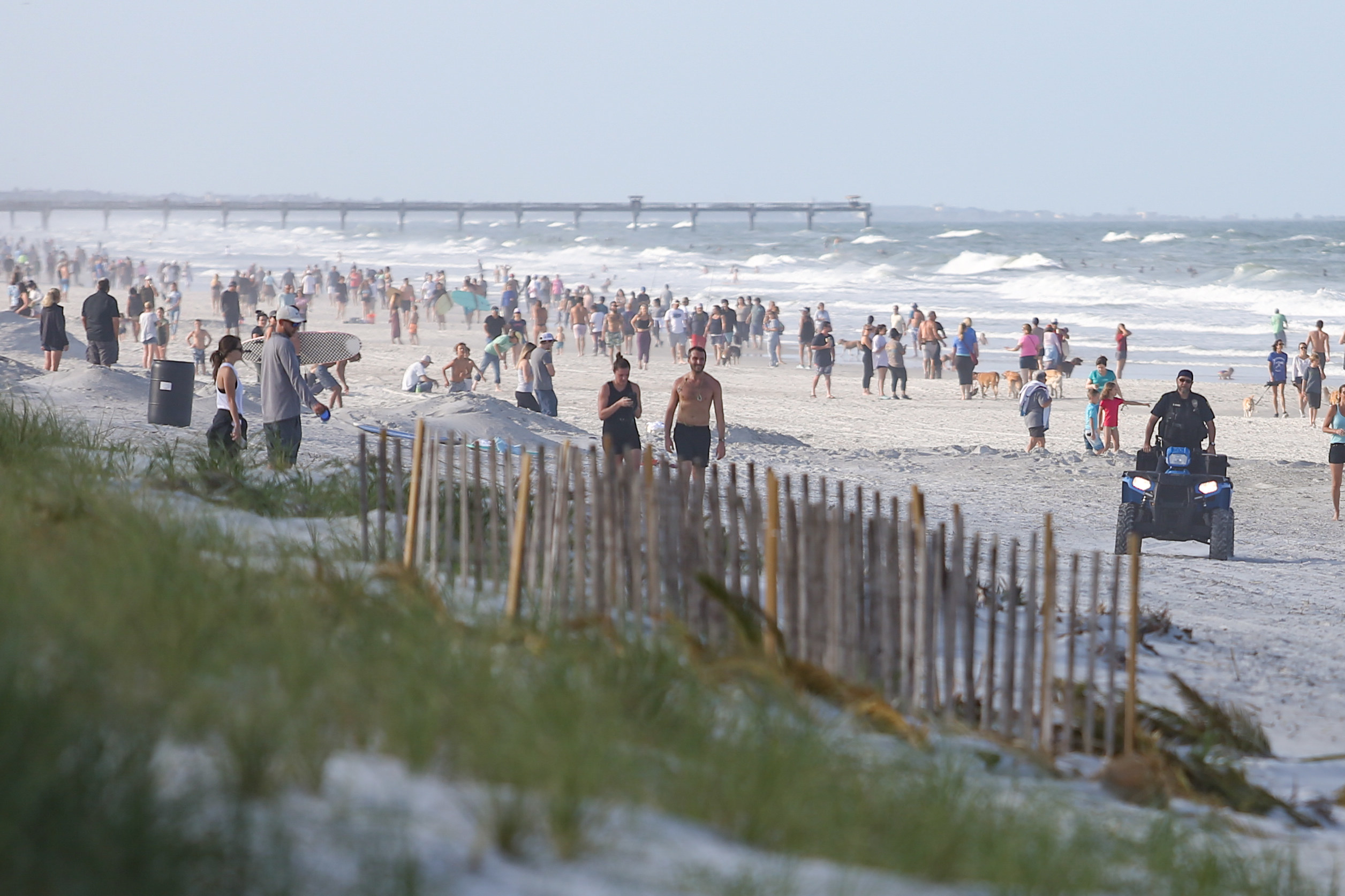
Adalja: If you’re trying to social distance and go to the beach, if you go at hours when it’s less crowded, then that’s always going to make it easier to social-distance.
Redfield: I’d go any time.
Kline: I do think that minimizing peak times is probably safer — going out when there are less likely to be crowds that would force you to be in closer contact to other people.
Glatt: It certainly is appropriate whenever you’re going out to avoid other people as much as possible. So I wouldn’t walk in an area where you knew it was very crowded. It doesn’t make sense. People are trying so hard to isolate, it would be a shame to ruin it.
Chowell: Try to go during the times when you don’t expect to see the peak activity, definitely. Maybe earlier or towards the end of the day.
Patel: I would avoid peak times when there are likely to be a lot of people around. This can vary widely based on the location. City parks become easily overwhelmed and may be best to avoid, especially on weekends or peak times such as during lunch hours, whereas [the] Minnesota state park where I hiked this weekend was virtually empty.
WOULD YOU MEET FRIENDS IN THE PARK IF YOU COULD MAINTAIN A 6-FOOT DISTANCE?

Adalja: Yes, I think that’s completely fine.
Redfield: Yes.
Glatt: Absolutely. Absolutely. But you have to do it right. I visit my children and grandchildren. We stay 10–15 feet away from each other and we interact for a short period of time in that fashion.
Patel: I would not meet friends there or recommend that kids use playground equipment, and I would avoid using restrooms (which would likely be closed). I would follow all recommended CDC precautions.
Kline: I think that it’s always riskier if you’re meeting somebody outside a family group. Right now, if people are sheltering at home, you’re sheltering with your own family or roommate or something, so you probably know if the other person is healthy or not. But if you make arrangements to join friends like that, you really don’t know as much about that person, so I think it’s a riskier situation.
I have seen people out doing that and I empathize because I know people are missing those human connections and they need to see their friends for mental health reasons, but I think if you’re doing that and you don’t know that everyone is COVID-free then it’s best to keep that distance and otherwise wear masks.
Otherwise I think those social gatherings, like going to a picnic with four friends together, that could put those groups at risk.
SHOULD I BE MAD AT IMAGES OF PEOPLE CROWDING PARKS AND BEACHES?
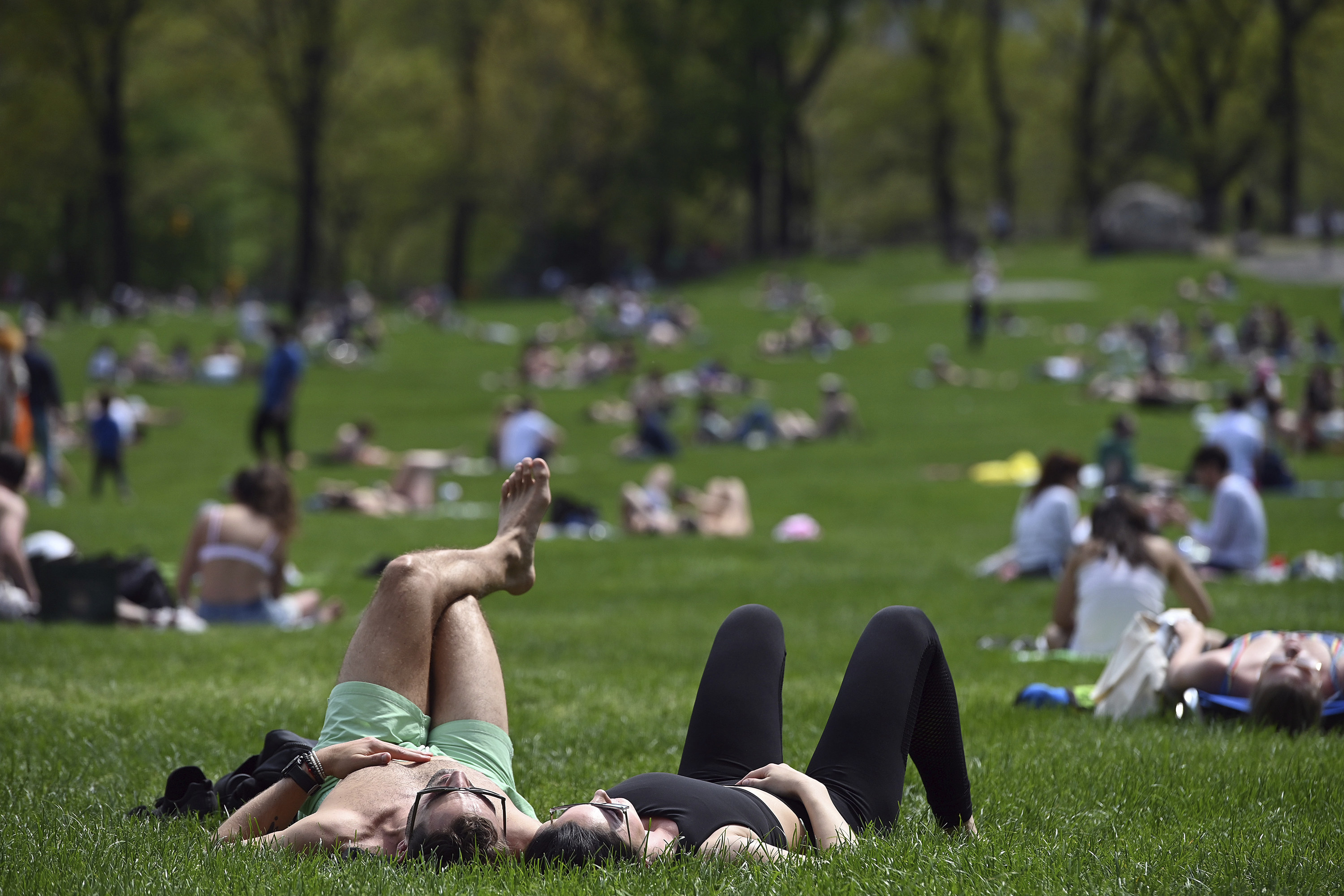
Adalja: I do think we've gotten to a place now where people are calling each other out for failing to adhere to social distancing norms. There’s a tendency for people to get into shaming-type behavior that might not be warranted.
I do think we’re going to go through this cycle where people are being shamed for not following social distancing and I think that’s going to be an unfortunate side effect. The only thing we can do is explain to people that this virus isn’t going anywhere. We still have to be smart, but now [that] we’re in a somewhat better place than we were two months ago, we’re going to see people’s risk perceptions change.
Chowell: I think that is definitely a reason to be annoyed after the amount of deaths that have been caused by a virus over just a few weeks and the fact that the epidemic is not over by any stretch of the imagination. The virus is still around in most parts of the country. That’s the reality. It’s definitely annoying and disrespectful for all those folks who have stayed at home and done their homework and followed the protocols. Seeing these pictures, it’s a sign of disrespect of society in a way and definitely disappointing — particularly to the most vulnerable, to those who are at high risk of death.
Due to this small fraction of people that for some reason are not yet educated about this virus, we could waste all of the progress that has been done so far.
Kline: I’m not sure it’s helpful to be angry. It’s valid to raise your concerns and I think if you’re putting other people at risk, then it’s probably a valid concern to raise publicly.
But I do think that being angry or berating people is probably not a helpful response, or shaming them. I don’t think that’s likely to change behavior.
I think reinforcing what safe social distancing guidelines should be is a worthwhile exercise. There should be clear standards and expectations.
UPDATE
This has been updated with comments from Robin Patel.
